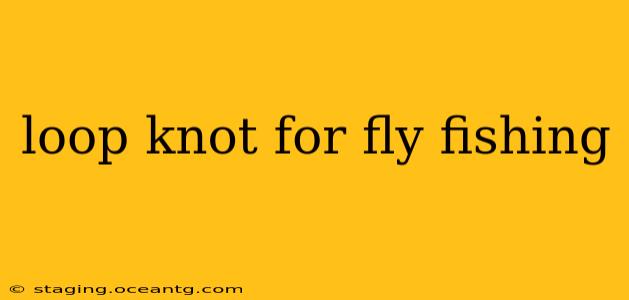The loop knot is a crucial element in any fly fisher's arsenal. Its ability to create a streamlined connection between leader and fly, improving presentation and minimizing tangles, makes it a favorite among anglers worldwide. This guide delves into the intricacies of tying the loop knot, addressing common questions and offering tips for achieving a perfect knot every time.
Why Use a Loop Knot for Fly Fishing?
The primary advantage of the loop knot is its enhanced fly presentation. Unlike knots that create a bulky connection, the loop allows the fly to move freely and naturally, mimicking the behavior of a real insect or baitfish. This subtle difference can significantly impact your success rate, especially when targeting discerning fish. Furthermore, a well-tied loop knot reduces the chances of tangles, a common frustration for fly fishers. It creates a cleaner, more efficient connection between your leader and tippet, allowing for smoother casts and improved accuracy.
How to Tie a Loop Knot: A Step-by-Step Guide
Several variations of the loop knot exist, but the most common and reliable is the improved clinch knot with a loop. Here’s how to tie it:
- Create the Loop: Start by creating a loop in your leader material, approximately the length of your fly.
- Improved Clinch Knot: Pass the tag end through the loop, then wrap it around the standing line 5-7 times.
- Secure the Knot: Thread the tag end through the initial loop created near the bend of the hook.
- Tighten Carefully: Gently moisten the knot and tighten carefully, making sure the wraps are snug against the standing line. Avoid pulling too hard, as this could damage the leader material.
Important Note: Practice tying the loop knot before hitting the water. Mastering the technique will save you time and frustration on the river.
What is the Best Material for Loop Knots?
The ideal material for your loop knot depends on your fishing situation and personal preference. However, fluorocarbon is generally preferred for its low visibility and strength. Nylon leaders can also work effectively, but they're more visible in clear water. The key is to choose a material that's appropriate for the size of your fly and the type of fish you're targeting.
What Size Loop Should I Use?
The optimal loop size depends on the size of your fly. As a general rule, aim for a loop that's slightly larger than your fly. This will provide enough space for the fly to move freely, without being overly bulky. Experiment with different loop sizes to find what works best for you.
How Do I Attach the Fly to the Loop?
Simply thread the hook eye of your fly through the loop you've created. Ensure that the loop is secured tightly to your leader, and that the fly hangs straight.
Can I Use a Loop Knot with All Flies?
While the loop knot is incredibly versatile, it might not be ideal for every type of fly. Larger flies or those with bulky bodies may require a different knot to ensure a secure connection. However, for the majority of fly fishing applications, the loop knot provides a superior connection.
Troubleshooting Common Loop Knot Problems:
- Knot Slips: This usually indicates insufficient wraps or improper tightening. Ensure you're using enough wraps and tightening the knot carefully.
- Knot Breaks: This suggests using too much force when tightening the knot or using damaged leader material. Always use fresh leader and avoid excessive force.
- Tangling: Incorrect loop size or poor knot placement can lead to tangles. Experiment with different loop sizes and practice your knot tying technique.
By understanding the benefits, techniques, and potential challenges of tying the loop knot, you will significantly enhance your fly fishing success. Remember practice makes perfect! With time and dedication, you'll be consistently tying flawless loop knots, resulting in better presentations and more successful fishing trips.
